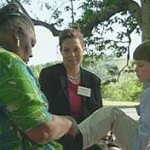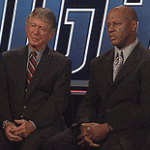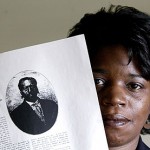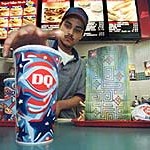Teacher’s Guide
The pursuit of excellence in covering race and ethnicity begins with a conversation about diversity, the umbrella under which these issues reside. It’s critical, then, to have a shared definition of what diversity means and a clear articulation of why it’s relevant to journalism.
Get chapter-by-chapter analyses of the stories highlighted in The Authentic Voice, tip sheets and interviews with the honored journalists about handling everything from getting people to speak candidly about race and ethnicity to writing with authority and depth.
Overview: The What and Why of Diversity
 People bring wildly differing answers to the questions of “what?” and “why?” depending on education, age, life experience, and myriad other factors. There’s no universal answer to either question, but journalism’s values of accuracy, truth, precision, and fairness provide excellent guidance. What do you mean when you say it? Here’s a three-part definition that grounds the “what” of diversity in journalism’s ethical values.
People bring wildly differing answers to the questions of “what?” and “why?” depending on education, age, life experience, and myriad other factors. There’s no universal answer to either question, but journalism’s values of accuracy, truth, precision, and fairness provide excellent guidance. What do you mean when you say it? Here’s a three-part definition that grounds the “what” of diversity in journalism’s ethical values.
Tug Of War: Minneapolis Star Tribune
 Reporter Allie Shah tells the stories of Fartun and Nimco in a way that allows the old and the new to have equal value; the tug-of-war doesn’t have a zero-sum outcome, where one culture wins and another loses (the frame for many such stories). Shah accomplishes this by checking her assumptions, learning more about the culture, and allowing her sources to define what is important to them.
Reporter Allie Shah tells the stories of Fartun and Nimco in a way that allows the old and the new to have equal value; the tug-of-war doesn’t have a zero-sum outcome, where one culture wins and another loses (the frame for many such stories). Shah accomplishes this by checking her assumptions, learning more about the culture, and allowing her sources to define what is important to them.
About Race: KRON-TV (San Francisco)
 The About Race series produced by KRON-TV in San Francisco stands as one of local television’s shining moments in the reporting about race and ethnicity. The stories challenged stereotypes and racial myths, replacing them with contemporary, easy-to-digest science and thought-provoking interviews. The process behind the series, involving lots of collaboration, self-examination, and a determination to push beyond the usual approach to storytelling on race and ethnicity, guides journalists who aspire to excellence in this arena.
The About Race series produced by KRON-TV in San Francisco stands as one of local television’s shining moments in the reporting about race and ethnicity. The stories challenged stereotypes and racial myths, replacing them with contemporary, easy-to-digest science and thought-provoking interviews. The process behind the series, involving lots of collaboration, self-examination, and a determination to push beyond the usual approach to storytelling on race and ethnicity, guides journalists who aspire to excellence in this arena.
Best of Friends, Worlds Apart: The New York Times
 Reporter Mirta Ojito attempts to show how racial identity can trump national heritage once an immigrant arrives on U.S. soil. Framed by the friendship of two Cuban men, the story sheds light on the divisive and formative power of stereotypes and assumptions based largely on skin color.
Reporter Mirta Ojito attempts to show how racial identity can trump national heritage once an immigrant arrives on U.S. soil. Framed by the friendship of two Cuban men, the story sheds light on the divisive and formative power of stereotypes and assumptions based largely on skin color.
The Family Secret: ABC News “20/20”
 The story follows Jill Atkin Sim through her stages of discovery about her black family and eventually travels with her to the reunion at Monticello. The story hinges on matters of identity—the fact that her forebears passed, Sim’s musings on her own racial identity, and the fact that she tells her son he is white and black.
The story follows Jill Atkin Sim through her stages of discovery about her black family and eventually travels with her to the reunion at Monticello. The story hinges on matters of identity—the fact that her forebears passed, Sim’s musings on her own racial identity, and the fact that she tells her son he is white and black.
The Color Line and The Bus Line: ABC News “Nightline”
 By weaving both hard fact and public opinion into the story “The Color Line and the Bus Line,” Anchor Ted Koppel and the ABC News Nightline team provided a roadmap to reporting in the multidimensional arena of race and ethnicity. Though the traffic accident that killed Cynthia Wiggins occurred in 1995, the issues at the core of this story are as relevant today as they were then.
By weaving both hard fact and public opinion into the story “The Color Line and the Bus Line,” Anchor Ted Koppel and the ABC News Nightline team provided a roadmap to reporting in the multidimensional arena of race and ethnicity. Though the traffic accident that killed Cynthia Wiggins occurred in 1995, the issues at the core of this story are as relevant today as they were then.
Broken Trust: Lee Enterprise Newspapers
 Mired in federal bureaucracy, obscured by history and beset by government and journalistic apathy, this story of Native land rights took a circuitous route to publication. Context, in the series, is everything, and reporter Jodi Rave makes excellent use of one core document—a massive federal court opinion—and a raft of established and new sources to tell the back story explaining the significance of Judge Royce C. Lamberth’s opinion and the enormity of the challenge before the courts.
Mired in federal bureaucracy, obscured by history and beset by government and journalistic apathy, this story of Native land rights took a circuitous route to publication. Context, in the series, is everything, and reporter Jodi Rave makes excellent use of one core document—a massive federal court opinion—and a raft of established and new sources to tell the back story explaining the significance of Judge Royce C. Lamberth’s opinion and the enormity of the challenge before the courts.
Teacher’s Guide: Broken Trust
Asian-American: ABC News “Nightline”
 In the ABC News Nightline story “Asian-American,” correspondent John Donvan and producer Mary Claude Foster present viewers with a full range of voices, context, and case studies to illustrate the palpable fear among many Asian Americans that the United States was about to repeat history with another “yellow scare.”
In the ABC News Nightline story “Asian-American,” correspondent John Donvan and producer Mary Claude Foster present viewers with a full range of voices, context, and case studies to illustrate the palpable fear among many Asian Americans that the United States was about to repeat history with another “yellow scare.”
Torn From The Land: The Associated Press
 Dolores Barclay and Todd Lewan of the Associated Press begin their series with this telling passage: “For generations, black families passed down the tales in uneasy whispers: ‘They stole our land.’” From there, the series traces the tumultuous, sometimes violent journey of property ownership, theft, and swindles and reveals some of the reasons for the muted voices.
Dolores Barclay and Todd Lewan of the Associated Press begin their series with this telling passage: “For generations, black families passed down the tales in uneasy whispers: ‘They stole our land.’” From there, the series traces the tumultuous, sometimes violent journey of property ownership, theft, and swindles and reveals some of the reasons for the muted voices.
Teacher’s Guide: Torn From the Land
Rim Of The New World: The Washington Post
 “Old South Goes with the Wind” is an inside-out view of a changing American landscape. A principal lesson from the story is the value of using the voice and language of the story’s characters. Reporter Anne Hull does this not just with a liberal use of quotes but with dialogue, the overheard exchanges between people inside and outside a Dairy Queen. The story taps into universal themes—aspiration, assimilation, rebellion—but tucks those grand notions into the action of smaller scenes and conversations.
“Old South Goes with the Wind” is an inside-out view of a changing American landscape. A principal lesson from the story is the value of using the voice and language of the story’s characters. Reporter Anne Hull does this not just with a liberal use of quotes but with dialogue, the overheard exchanges between people inside and outside a Dairy Queen. The story taps into universal themes—aspiration, assimilation, rebellion—but tucks those grand notions into the action of smaller scenes and conversations.
The Death of LcPL Gutierrez: CBS News “60 Minutes”
 Producer Steve Glauber and Correspondent Bob Simon explore the life of a street child from Guatemala who crossed border lines into the United States, lied to immigration officers to get a green card, and then died in Iraq, hailed by many as a war hero. One of the most valuable features of the piece is the sorely needed balance it provides to the many news stories that cast illegal immigrants only as takers who drain the system of resources.
Producer Steve Glauber and Correspondent Bob Simon explore the life of a street child from Guatemala who crossed border lines into the United States, lied to immigration officers to get a green card, and then died in Iraq, hailed by many as a war hero. One of the most valuable features of the piece is the sorely needed balance it provides to the many news stories that cast illegal immigrants only as takers who drain the system of resources.
Diverse and Divided & A Tale Of Two Cultures: The Record (N.J.)
 Reporter Elizabeth Llorente provides a template for writing stories about changing communities. She taps into what she calls the “phantom dialogue” of race and ethnic relations to reveal the harsh, poignant, and often contradictory truths at work in two New Jersey towns. Her descriptive account of group clashes and individual frustrations in Diverse and Divided brings the reader to a deeper understanding of the complexity of relationships in a small city.
Reporter Elizabeth Llorente provides a template for writing stories about changing communities. She taps into what she calls the “phantom dialogue” of race and ethnic relations to reveal the harsh, poignant, and often contradictory truths at work in two New Jersey towns. Her descriptive account of group clashes and individual frustrations in Diverse and Divided brings the reader to a deeper understanding of the complexity of relationships in a small city.
Rape of Nanking: KRON-TV (San Francisco)
 Reporter Emerald Yeh presents just the right combination of images and dialogue to recount the rapes and murders of an estimated 300,000 Chinese civilians by Japanese soldiers during the World War II–era rampage. Yeh succeeds in telling the story of the Rape of Nanking in its historical context while exploring implications for a twenty-first century couple with ties to both sides. Yeh aims for fairness by giving voice to the many sides of the story.
Reporter Emerald Yeh presents just the right combination of images and dialogue to recount the rapes and murders of an estimated 300,000 Chinese civilians by Japanese soldiers during the World War II–era rampage. Yeh succeeds in telling the story of the Rape of Nanking in its historical context while exploring implications for a twenty-first century couple with ties to both sides. Yeh aims for fairness by giving voice to the many sides of the story.
The Other Pro Soccer: The Washington Post
 A season in the life of Latino soccer teams ringing the Washington, D.C., area could mean a wealth of feature stories on the immigrant team members, owners, and fans. But Reporter Gabriel Escobar dives deeper into the history of the competition and returns with a narrative filled with complexity.
A season in the life of Latino soccer teams ringing the Washington, D.C., area could mean a wealth of feature stories on the immigrant team members, owners, and fans. But Reporter Gabriel Escobar dives deeper into the history of the competition and returns with a narrative filled with complexity.
